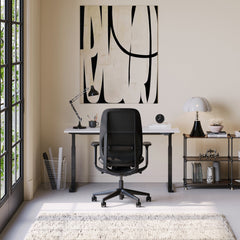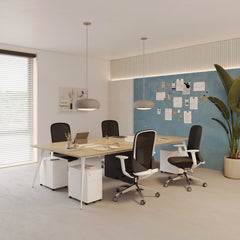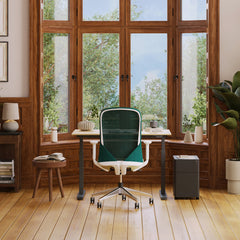Get 10% off your first order
Find the office furniture that’s designed to match your style, comfort, and needs perfectly. Subscribe
Beyond Desks and Chairs: How Cohesive Design Shapes Your Office Brand

Visit quiz page to see how we makes it easy to create an inspiring workplace


You spend hours at your desk every day, but have you ever stopped to ask if it’s actually working for you? Ergonomic design isn’t about luxury—it’s about alignment, comfort, and better energy flow.
Whether you sit, stand, or shift throughout the day, your desk setup plays a huge role in how focused and comfortable you feel. Let’s walk through an ergonomic checklist that helps you create a workspace that supports your body and your workflow.
Ergonomics centers around fitting the workspace to the person—not the other way around. A comfortable setup reduces strain and supports long-term health.
Keep your body in a neutral position.
Align monitor height with your natural eye line.
Avoid excessive reach or bending.
Allow movement throughout your workday.
A workspace that supports your body leads to clarity and consistent productivity.
Your desk height affects how your shoulders, neck, and wrists align during work. If your elbows sit higher than your desk, tension builds quickly.
A flexible design like the Small Standing Desk Indiana allows you to move between sitting and standing with ease, preventing stiffness and fatigue.
|
Height |
Ideal Desk Level |
Posture Focus |
|
5’0”–5’5” |
26–28 inches |
Relaxed shoulders |
|
5’6”–6’0” |
28–30 inches |
Neutral elbow position |
|
6’1”–6’4” |
30–32 inches |
Upright balance |
|
Adjustable |
Variable |
Personalized comfort |
Proper height prevents slouching, shoulder strain, and wrist pain.
Slouching or leaning forward often means your desk or screen isn’t aligned with your body’s natural posture. Fixing these small issues can drastically improve focus.
Keep your feet flat on the floor.
Relax your shoulders away from your ears.
Position your monitor slightly below eye level.
Keep your spine in a neutral S-curve.
A strong ergonomic foundation begins with how you sit—and how your workspace supports that.
Remaining in one position for hours limits circulation and energy. The best ergonomic setups encourage gentle movement throughout the day.
A height-adjustable standing desk helps break long sitting sessions while maintaining posture.
Stand for 15 minutes each hour.
Stretch your wrists and shoulders regularly.
Walk during calls or breaks.
Alternate between sitting and standing positions.
Movement keeps your body alert and your mind sharp.
Ergonomic design also means arranging your tools efficiently. Reaching, twisting, or leaning too often can create long-term strain.
Place essentials within arm’s reach.
Keep your keyboard and mouse aligned with your elbows.
Store rarely used items out of your main zone.
Maintain a clutter-free surface for ease of motion.
Your workspace should feel like an extension of your movement, not an obstacle.
Your desk and chair should work in harmony. A mismatch between height and angle can cause discomfort even in short periods of use.
|
Element |
Ideal Feature |
Ergonomic Benefit |
|
Chair height |
Matches desk level |
Aligns shoulders |
|
Seat depth |
Supports thighs fully |
Improves blood flow |
|
Armrests |
Adjustable |
Reduces shoulder tension |
|
Cushioning |
Medium-firm |
Encourages posture balance |
When the chair supports your desk, the whole setup works in your favor.

Lighting shapes how you interact with your screen. A poor setup can cause squinting, neck strain, and fatigue.
Position your monitor 20–30 inches from your eyes.
Keep light sources beside, not behind, your screen.
Use warm ambient lighting to soften contrast.
Adjust brightness to match the time of day.
Balanced lighting keeps you focused without tension or strain.
Research from workspace psychology studies shows that a comfortable workspace improves concentration and emotional stability. When your physical environment feels aligned, your mind follows.
Ergonomic setups reduce mental fatigue.
Balanced design promotes consistent focus.
Comfort boosts motivation and task completion.
Physical ease supports creative thinking.
A healthy desk setup doesn’t just improve how you sit—it reshapes how you think.
Shared offices and studios require flexible layouts. A modular quad workstation allows each user to adjust their position while maintaining a cohesive design.
Equip each section with adjustable elements.
Keep walkways open for movement.
Provide equal lighting and accessibility.
Create separation for focus when needed.
Flexibility is the future of ergonomic design—it adapts to everyone’s rhythm.
Ergonomics becomes more powerful when shared across teams. A six-person workstation desk can keep posture and comfort consistent among colleagues while fostering collaboration.
Ensure uniform screen heights across setups.
Encourage regular breaks for movement.
Match seating support across stations.
Design work zones with airflow and lighting in mind.
A team that works comfortably works cohesively.
The materials you work with affect not only durability but also comfort. Smooth, soft-touch surfaces reduce tension and create sensory ease throughout the day.
A well-built office desk blends form and function, providing tactile comfort with structural integrity.
|
Material |
Benefit |
Feel |
|
Matte wood |
Gentle on wrists |
Warm |
|
Soft metal |
Strong yet smooth |
Balanced |
|
Laminate |
Easy to clean |
Sleek |
|
Fabric |
Adds softness |
Inviting |
Designing with material comfort in mind completes the ergonomic experience.
Use this checklist to determine if your desk setup supports your comfort and productivity.
Are your elbows and wrists relaxed while typing?
Can your feet rest flat on the floor?
Does your screen sit slightly below eye level?
Is your back fully supported by your chair?
Do you feel balanced when standing or sitting?
A quick check helps you notice early signs of strain before they become discomfort.
Lighting and color directly affect how your workspace feels and functions. Harsh or uneven light can cause squinting and tension, while color influences energy and focus. Together, they complete the ergonomic experience.
Use warm-toned lighting to reduce glare and eye fatigue.
Keep your monitor perpendicular to natural light sources.
Choose neutral or earth-toned walls for calm and focus.
Add accent lighting for evening balance and warmth.
Visual comfort is just as important as posture—it keeps your space physically and mentally supportive.
Your environment’s temperature and air circulation play a hidden but powerful role in comfort and concentration. Even a well-adjusted standing desk can’t compensate for discomfort caused by a stale or cold environment.
|
Factor |
Ideal Range |
Benefit |
|
Temperature |
68–72°F |
Keeps alertness steady |
|
Humidity |
30–50% |
Prevents dryness and fatigue |
|
Airflow |
Gentle and consistent |
Reduces restlessness |
|
Scents |
Natural, light |
Enhances focus |
A workspace that breathes well feels better, functions better, and helps you work longer without tension.
Technology can either simplify your workflow or complicate it. Integrating ergonomic principles into your tech setup ensures your tools enhance—not interrupt—your movement.
Keep the laptop standing at eye level for better posture.
Use wireless keyboards and mice to reduce desk clutter.
Organize cables to free arm movement.
Opt for dual monitors only if it improves workflow balance.
Technology should feel like part of your workspace—not the reason for your discomfort.

Ergonomics isn’t complicated—it’s thoughtful. It’s the small adjustments, quality materials, and flexible designs that keep your mind focused and your body supported.
Comfort fuels consistency.
Movement builds momentum.
Design impacts both energy and emotion.
A supportive workspace strengthens performance.
A desk designed for you will always bring out your best work—because true productivity starts with comfort.

Beyond Desks and Chairs: How Cohesive Design Shapes Your Office Brand

The Silent Energy Drain: Designing Tables and Chairs That Fight Work Fatigue

The Performance Equation: Unlocking Employee Potential with Ergonomic Design
Get 10% off your first order
Find the office furniture that’s designed to match your style, comfort, and needs perfectly. Subscribe
Leave a comment